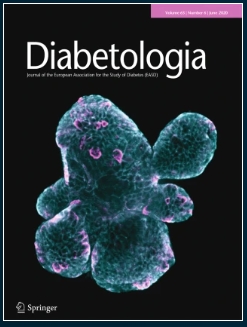GLP-1/GIP/GCG receptor triagonist (IUB447) enhances insulin secretion via GLP-1 receptor and Gαq signalling pathway in mice.
IF 10.2
1区 医学
Q1 ENDOCRINOLOGY & METABOLISM
引用次数: 0
Abstract
AIMS/HYPOTHESIS Unimolecular peptides targeting the receptors for glucagon-like peptide-1 (GLP-1), glucose-dependent insulinotropic polypeptide (GIP) and glucagon (GCG) have been shown to improve glycaemic management in both mice and humans. Yet the identity of the downstream signalling events mediated by these peptides remain to be elucidated. Here, we aimed to assess the mechanisms by which a validated peptide triagonist for GLP-1/GIP/GCG receptors (IUB447) stimulates insulin secretion in murine pancreatic islets. METHODS Islets were isolated from wild-type (WT), Gipr-knockout (Gipr-/-), Gcgr-knockout (Gcgr-/-), Glp-1r (also known as Glp1r)/Gipr double-knockout and Trpm5-knockout (Trpm5-/-) mice, followed by assessment of beta cell function and insulin secretion in response to mono- and multi-agonist administration. Metabolic phenotypes of WT and Trpm5-/- mice under chow and high-fat diets were investigated following triagonist application. RESULTS The triagonist promoted glucose-stimulated insulin secretion (GSIS) to a greater degree than co-administration of conventional mono-agonists in WT mouse islets. The triagonist-induced increase in GSIS was unchanged in the absence of either Gipr or Gcgr. However, the triagonist failed to enhance insulin secretion in islets lacking both Glp-1r and Gipr and upon treatment with the GLP-1 receptor-specific antagonist exendin-3 (9-39). Similarly, the specific blocking of Gαq signalling with YM254890 or transient receptor potential melastatin 5 (TRPM5) with triphenylphosphine oxide (TPPO) suppressed the triagonist-induced enhancement of GSIS. In vivo assessment of high-fat-fed Trpm5-/- mice demonstrated the absence of triagonist-induced therapeutic effects on glycaemic management. CONCLUSIONS/INTERPRETATION Triagonist-induced augmentation of GSIS is primarily mediated through its interaction with the GLP-1 receptor and subsequent activation of the Gαq-TRPM5 signalling pathway. Given that Gαq is a key player in the amplification of GSIS, particularly under diabetic conditions, these findings highlight a GLP-1 receptor-centric pharmacological profile that underlies the potent effects of this multi-receptor agonist.GLP-1/GIP/GCG受体三激动剂(IUB447)通过GLP-1受体和g - αq信号通路增强小鼠胰岛素分泌。
针对胰高血糖素样肽-1 (GLP-1)、葡萄糖依赖性胰岛素性多肽(GIP)和胰高血糖素(GCG)受体的单分子肽已被证明可以改善小鼠和人类的血糖管理。然而,由这些肽介导的下游信号事件的身份仍有待阐明。在这里,我们旨在评估经验证的GLP-1/GIP/GCG受体肽三激动剂(IUB447)刺激小鼠胰岛胰岛素分泌的机制。方法从野生型(WT)、Gipr-敲除(Gipr-/-)、Gcgr-敲除(Gcgr-/-)、Glp-1r(也称为Glp1r)/Gipr双敲除和Trpm5-敲除(Trpm5-/-)小鼠中分离小细胞,然后评估单剂和多剂给药对β细胞功能和胰岛素分泌的影响。应用三角拮抗剂后,研究了高脂饮食下WT和Trpm5-/-小鼠的代谢表型。结果在WT小鼠胰岛中,与常规单受体激动剂相比,三受体激动剂促进葡萄糖刺激胰岛素分泌(GSIS)的程度更大。在没有Gipr或Gcgr的情况下,三角受体拮抗剂诱导的GSIS升高没有变化。然而,在GLP-1受体特异性拮抗剂exendin-3治疗后,triagonists未能增强缺乏Glp-1r和Gipr的胰岛的胰岛素分泌(9-39)。同样,用YM254890特异性阻断Gαq信号或用氧化三苯基膦(TPPO)特异性阻断瞬时受体电位美拉他汀5 (TRPM5)可抑制三角激动剂诱导的GSIS增强。对高脂肪喂养的Trpm5-/-小鼠的体内评估表明,triagonist对血糖管理没有诱导的治疗作用。结论/解释:triagonists诱导的GSIS增强主要是通过其与GLP-1受体的相互作用以及随后g - αq- trpm5信号通路的激活介导的。鉴于Gαq是GSIS扩增的关键参与者,特别是在糖尿病条件下,这些发现强调了GLP-1受体为中心的药理学特征,这是这种多受体激动剂有效作用的基础。
本文章由计算机程序翻译,如有差异,请以英文原文为准。
求助全文
约1分钟内获得全文
求助全文
来源期刊

Diabetologia
医学-内分泌学与代谢
CiteScore
18.10
自引率
2.40%
发文量
193
审稿时长
1 months
期刊介绍:
Diabetologia, the authoritative journal dedicated to diabetes research, holds high visibility through society membership, libraries, and social media. As the official journal of the European Association for the Study of Diabetes, it is ranked in the top quartile of the 2019 JCR Impact Factors in the Endocrinology & Metabolism category. The journal boasts dedicated and expert editorial teams committed to supporting authors throughout the peer review process.
 求助内容:
求助内容: 应助结果提醒方式:
应助结果提醒方式:


